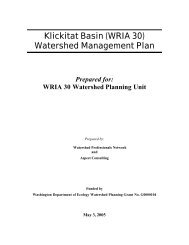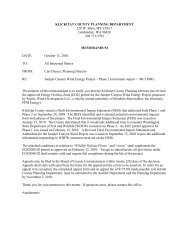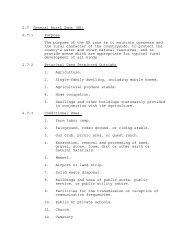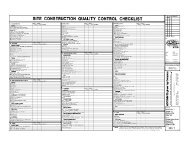WRIA 31 Instream Habitat Assessment
WRIA 31 Instream Habitat Assessment - Klickitat County Home
WRIA 31 Instream Habitat Assessment - Klickitat County Home
Create successful ePaper yourself
Turn your PDF publications into a flip-book with our unique Google optimized e-Paper software.
The primary plowed/planted agricultural lands are within the Glade Creek subbasin andinclude rotations of winter wheat and fallow land, row crops, and wine grapes. Primaryrow crops include corn, peas, beans, and potatoes (personal communications, June 5,1009, Troy Grimes, ConAgra farm and dairy operations manager; and WA Dept. ofAgriculture database 2006). Land in the northern portion of the subbasin is not irrigated.Center pivot irrigation is used on row crops in the southern portion of the basin, generallyfrom March through October. Some row crops have multiple rotations within the year,and a cover crop is generally planted to provide erosion control over winter. There arealso limited plowed/planted lands within the otherstudy subbasins.Since there is no detailed GIS information onspecific crops, and rotations change through time,the WEPP model was used to calculate erosion anddelivery to streams from several representativescenarios (Table 3). For all runs, the Richland WAclimate and the Shano silt loam soil was used.Slopes of 2, 5, 10, 20, 30, 40, and 50% with 1,000foot lengths were modeled. Management filesincluded the standard WEPP-provided winter wheatmulch tilled, winter wheat conventional tilled,winter wheat no till, fallow tilled, to represent therange of dryland farming methods in the northernpart of the basin. Several WEPP runs were made toCover crops between grape vinesreduce surface erosiondetermine the range of predicted erosion from irrigated land, including: corn spring chiselplow (with and without irrigation), corn no till winter wheat cover crop (no irrigation),and three different no till, irrigation, with winter wheat cover crop scenarios (sweet corn,peas, and potatoes).Table 3. WEPP estimates of erosion from various cultivated land uses (average tons/acre/year).HillSlopeGradient(%)Winterwheat,continuousno tillWinterwheat,conventionaltillWinterwheat,mulchtillWinterwheat,continuousno till,stationarydepletionirrigation(Mar-0ct)Winterwheat,conventionaltill, stationarydepletionirrigation(Mar-Oct)Corn,springchiselplow (noirrigation)Corn, notill, winterwheatcovercrop (noirrigation)Corn,springchiselplow,stationarydepletionirrigation(Mar-Oct)Sweetcorn, notill, winterwheatcover crop,stationarydepletionirrigation(Mar-Oct)Peas, notill, winterwheatcovercrop,stationarydepletionirrigation(Mar-Oct)Potatoes,no till,winterwheatcovercrop,stationarydepletionirrigation(Mar-Oct)2 0 0 0 0 0.01 0 0 0 0 0 05 0 0.1 0 0 0.1 0 0 0.3 0 0.1 0.110 0 0.3 0.2 0 0.7 0.2 0.1 1.3 0.4 0.3 0.220 0.1 1.2 0.8 0.1 4.9 0.7 0.3 4 1 0.7 0.930 0.2 2.1 1.5 0.4 10.1 1.3 0.6 7.6 1.6 1.1 1.140 0.3 3.1 2.3 0.9 15 1.9 0.8 10.9 2.2 1.5 250 0.4 4.4 2.9 1.1 19.7 2.5 1.3 14.4 3.2 1.9 3The WEPP results were compiled into three average rates that were used for the threecultivated land use categories available in the GIS coverage: Cultivated irrigated;<strong>WRIA</strong> <strong>31</strong> <strong>Instream</strong> <strong>Habitat</strong> <strong>Assessment</strong> 15 Watershed Professionals Network









